Validating Rainfall-Runoff Modelling Using Satellite-Based and Reanalysis Precipitation Products in the Sre Pok Catchment, the Mekong River Basin
Abstract
:1. Introduction
2. Materials and Methods
2.1. The Study Area
2.2. Data Used
2.3. Method of Data Comparison
2.4. Rainfall-Runoff Model: HBV-Light
2.4.1. Model Setup
2.4.2. Model Simulations
2.4.3. Evaluation Indicators
3. Results and Discussion
3.1. Validation of SBRP against GMP
3.2. Runoff Simulations
3.2.1. Runoff Simulation at Daily Timescale
3.2.2. Runoff Aggregation at Monthly Timescale
4. Summary and Conclusions
Author Contributions
Acknowledgments
Conflicts of Interest
References
- Jeniffer, K.; Su, Z.; Woldai, T.; Maathuis, B. Estimation of spatial–temporal rainfall distribution using remote sensing techniques: A case study of Makanya catchment, Tanzania. Int. J. Appl. Earth Obs. Geoinf. 2010, 12 (Suppl. 1), S90–S99. [Google Scholar] [CrossRef]
- Li, F.; Zhang, Y.; Xu, Z.; Liu, C.; Zhou, Y.; Liu, W. Runoff predictions in ungauged catchments in southeast Tibetan Plateau. J. Hydrol. 2014, 511, 28–38. [Google Scholar] [CrossRef]
- Duan, Z.; Bastiaanssen, W.G.M. First results from Version 7 TRMM 3B43 precipitation product in combination with a new downscaling–calibration procedure. Remote Sens. Environ. 2013, 131, 1–13. [Google Scholar] [CrossRef]
- Woldemeskel, F.M.; Sivakumar, B.; Sharma, A. Merging gauge and satellite rainfall with specification of associated uncertainty across Australia. J. Hydrol. 2013, 499, 167–176. [Google Scholar] [CrossRef]
- Behrangi, A.; Khakbaz, B.; Jaw, T.C.; AghaKouchak, A.; Hsu, K.; Sorooshian, S. Hydrologic evaluation of satellite precipitation products over a mid-size basin. J. Hydrol. 2011, 397, 225–237. [Google Scholar] [CrossRef]
- Collischonn, B.; Collischonn, W.; Tucci, C.E.M. Daily hydrological modeling in the Amazon basin using TRMM rainfall estimates. J. Hydrol. 2008, 360, 207–216. [Google Scholar] [CrossRef]
- Li, M.; Shao, Q. An improved statistical approach to merge satellite rainfall estimates and raingauge data. J. Hydrol. 2010, 385, 51–64. [Google Scholar] [CrossRef]
- Mishra, A.K.; Gairola, R.M.; Varma, A.K.; Agarwal, V.K. Improved rainfall estimation over the Indian region using satellite infrared technique. Adv. Space Res. 2011, 48, 49–55. [Google Scholar] [CrossRef]
- Hunink, J.E.; Immerzeel, W.W.; Droogers, P. A High-resolution Precipitation 2-step mapping Procedure (HiP2P): Development and application to a tropical mountainous area. Remote Sens. Environ. 2014, 140, 179–188. [Google Scholar] [CrossRef]
- Jamandre, C.A.; Narisma, G.T. Spatio-temporal validation of satellite-based rainfall estimates in the Philippines. Atmos. Res. 2013, 122, 599–608. [Google Scholar] [CrossRef]
- Hrachowitz, M.; Savenije, H.; Blöschl, G.; McDonnell, J.; Sivapalan, M.; Pomeroy, J.; Arheimer, B.; Blume, T.; Clark, M.; Ehret, U. A decade of Predictions in Ungauged Basins (PUB)—A review. Hydrol. Sci. J. 2013, 58, 1198–1255. [Google Scholar] [CrossRef]
- Meng, J.; Li, L.; Hao, Z.; Wang, J.; Shao, Q. Suitability of TRMM satellite rainfall in driving a distributed hydrological model in the source region of Yellow River. J. Hydrol. 2014, 509, 320–332. [Google Scholar] [CrossRef]
- Bitew, M.M.; Gebremichael, M. Evaluation of satellite rainfall products through hydrologic simulation in a fully distributed hydrologic model. Water Resour. Res. 2011, 47. [Google Scholar] [CrossRef]
- Li, X.H.; Zhang, Q.; Xu, C.Y. Suitability of the TRMM satellite rainfalls in driving a distributed hydrological model for water balance computations in Xinjiang catchment, Poyang lake basin. J. Hydrol. 2012, 426, 28–38. [Google Scholar] [CrossRef]
- Su, F.; Hong, Y.; Lettenmaier, D.P. Evaluation of TRMM Multisatellite Precipitation Analysis (TMPA) and Its Utility in Hydrologic Prediction in the La Plata Basin. J. Hydrometeorol. 2008, 9, 622–640. [Google Scholar] [CrossRef]
- Thiemig, V.; Rojas, R.; Zambrano-Bigiarini, M.; De Roo, A. Hydrological evaluation of satellite-based rainfall estimates over the Volta and Baro-Akobo Basin. J. Hydrol. 2013, 499, 324–338. [Google Scholar] [CrossRef]
- Wu, H.; Adler, R.F.; Hong, Y.; Tian, Y.; Policelli, F. Evaluation of global flood detection using satellite-based rainfall and a hydrologic model. J. Hydrometeorol. 2012, 13, 1268–1284. [Google Scholar] [CrossRef]
- Artan, G.; Gadain, H.; Smith, J.L.; Asante, K.; Bandaragoda, C.J.; Verdin, J.P. Adequacy of satellite derived rainfall data for stream flow modeling. Nat. Hazards 2007, 43, 167–185. [Google Scholar] [CrossRef]
- Jiang, S.; Ren, L.; Hong, Y.; Yong, B.; Yang, X.; Yuan, F.; Ma, M. Comprehensive evaluation of multi-satellite precipitation products with a dense rain gauge network and optimally merging their simulated hydrological flows using the Bayesian model averaging method. J. Hydrol. 2012, 452–453, 213–225. [Google Scholar] [CrossRef]
- Hong, Y.; Adler, R.F.; Hossain, F.; Curtis, S.; Huffman, G.J. A first approach to global runoff simulation using satellite rainfall estimation. Water Resour. Res. 2007, 43. [Google Scholar] [CrossRef]
- Müller, M.F.; Thompson, S.E. Bias adjustment of satellite rainfall data through stochastic modeling: Methods development and application to Nepal. Adv. Water Resour. 2013, 60, 121–134. [Google Scholar] [CrossRef]
- Hong, Y.; Hsu, K.-L.; Moradkhani, H.; Sorooshian, S. Uncertainty quantification of satellite precipitation estimation and Monte Carlo assessment of the error propagation into hydrologic response. Water Resour. Res. 2006, 42. [Google Scholar] [CrossRef]
- Yilmaz, K.K.; Hogue, T.S.; Hsu, K.-L.; Sorooshian, S.; Gupta, H.V.; Wagener, T. Intercomparison of rain gauge, radar, and satellite-based precipitation estimates with emphasis on hydrologic forecasting. J. Hydrometeorol. 2005, 6, 497–517. [Google Scholar] [CrossRef]
- Mekong River Commission; Asian Development Bank. RE: Update Hydrological Model (ARCSWAT), Pakse to Kratie; Mekong River Commission; Asian Development Bank: Vientiane, Lao PDR, 2010. [Google Scholar]
- Building River Dialogue and Governance (BRIDGE). 3S Basin. 2014. Available online: http://www.3sbasin.org/knowledge/3ss-profile/hydrology.html (accessed on 6 September 2014).
- Building River Dialogue and Governance (BRIDGE). Profile: The Sre Pok Basin. 2015. Available online: http://www.3sbasin.org/publication/download-documents.html (accessed on 6 March 2015).
- Huffman, G.; Adler, R.; Bolvin, D.; Nelkin, E. The TRMM Multi-Satellite Precipitation Analysis (TMPA). In Satellite Rainfall Applications for Surface Hydrology; Gebremichael, M., Hossain, F., Eds.; Springer: Dordrecht, The Netherlands, 2010. [Google Scholar]
- Joyce, R.J.; Janowiak, J.E.; Arkin, P.A.; Xie, P. CMORPH: A Method that Produces Global Precipitation Estimates from Passive Microwave and Infrared Data at High Spatial and Temporal Resolution. J. Hydrometeorol. 2004, 5, 487–503. [Google Scholar] [CrossRef]
- Dee, D.P.; Uppala, S.M.; Simmons, A.J.; Berrisford, P.; Poli, P.; Kobayashi, S.; Andrae, U.; Balmaseda, M.A.; Balsamo, G.; Bauer, P.; et al. The ERA-Interim reanalysis: configuration and performance of the data assimilation system. Q. J. R. Meteorol. Soc. 2011, 137, 553–597. [Google Scholar] [CrossRef]
- Hagedorn, R.; Hamill, T.M.; Whitaker, J.S. Probabilistic forecast calibration using ECMWF and GFS ensemble reforecasts. Part I: Two-meter temperatures. Mon. Weather Rev. 2008, 136, 2608–2619. [Google Scholar] [CrossRef]
- Huffman, G.J.; Bolvin, D.T. TRMM and Other Data Precipitation Data Set Documentation. NASA; 2014. Available online: ftp://meso-a.gsfc.nasa.gov/pub/trmmdocs/3B42_3B43_doc.pdf (accessed on 20 December 2014).
- Derin, Y.; Yilmaz, K.K. Evaluation of Multiple Satellite-Based Precipitation Products over Complex Topography. J. Hydrometeorol. 2014, 15, 1498–1516. [Google Scholar] [CrossRef] [Green Version]
- Thiemig, V.; Rojas, R.; Zambrano-Bigiarini, M.; Levizzani, V.; De Roo, A. Validation of satellite-based precipitation products over sparsely gauged African river basins. J. Hydrometeorol. 2012, 13, 1760–1783. [Google Scholar] [CrossRef]
- Demirtas, M.; Nance, L.; Bernardet, L.; Lin, Y.; Chuang, H.-Y.; Loughe, A.; Mahoney, J.; Gall, R.; Koch, S. The Developmental Testbed Center Verification System. 2005. Available online: http://www2.mmm.ucar.edu/wrf/users/workshops/WS2005/abstracts/Session3/23-DEMIRTAS.pdf (accessed on 24 March 2018).
- Gao, Y.C.; Liu, M.F. Evaluation of high-resolution satellite precipitation products using rain gauge observations over the Tibetan Plateau. Hydrol. Earth Syst. Sci. 2013, 17, 837–849. [Google Scholar] [CrossRef]
- Sapiano, M.R.P.; Arkin, P.A. An Intercomparison and Validation of High-Resolution Satellite Precipitation Estimates with 3-Hourly Gauge Data. J. Hydrometeorol. 2009, 10, 149–166. [Google Scholar] [CrossRef]
- Seibert, J. HBV Light Version 2, User’s Manual; Department of Forest Engineering Corvallis, Oregon State University: Corvallis, OR, USA; Department of Earth Science, Hydrology, Uppsala University: Uppsala, Sweden, 2002. [Google Scholar]
- Lidén, R.; Harlin, J. Analysis of conceptual rainfall–runoff modelling performance in different climates. J. Hydrol. 2000, 238, 231–247. [Google Scholar] [CrossRef]
- Love, D.; Uhlenbrook, S.; Corzo-Perez, G.; Twomlow, S.; van der Zaag, P. Rainfall–interception–evaporation–runoff relationships in a semi-arid catchment, northern Limpopo basin, Zimbabwe. Hydrol. Sci. J. 2010, 55, 687–703. [Google Scholar] [CrossRef] [Green Version]
- Masih, I.; Uhlenbrook, S.; Maskey, S.; Ahmad, M.D. Regionalization of a conceptual rainfall–runoff model based on similarity of the flow duration curve: A case study from the semi-arid Karkheh basin, Iran. J. Hydrol. 2010, 391, 188–201. [Google Scholar] [CrossRef]
- Uhlenbrook, S.; Seibert, J.A.N.; Leibundgut, C.; Rodhe, A. Prediction uncertainty of conceptual rainfall–runoff models caused by problems in identifying model parameters and structure. Hydrol. Sci. J. 1999, 44, 779–797. [Google Scholar] [CrossRef]
- Arheimer, B.; Lindström, G.; Olsson, J. A systematic review of sensitivities in the Swedish flood-forecasting system. Atmos. Res. 2011, 100, 275–284. [Google Scholar] [CrossRef]
- Sarkkula, J.; Kiirikki, M.; Koponen, J.; Kummu, M. Ecosystem processes of the Tonle Sap Lake. In Proceedings of the 1st Workshop of Ecotone Phase II, Phnom Penh and Siem Reap, Cambodia, 26 October to 1 November 2003. [Google Scholar]
- Sarkkula, J.; Koponen, J.; Keskinen, M.; Kummu, M.; Inkala, A.; Käkönen, M.; Lamberts, D.; Lauri, H.; Varis, O.; Veijalainen, N.; et al. Hydrological, Environmental and Socio-Economic Modelling Tools for the Lower Mekong Basin Impact Assessment; Research Findings and Recommendations; Mekong River Commission; Finnish Environment Institute Consultancy Consortium: Vientiane, Lao PDR, 2007. [Google Scholar]
- Hargreaves, G.H.; Samani, Z.A. Reference crop evapotranspiration from ambient air temperature. Appl. Eng. Agric. 1985, 1, 96–99. [Google Scholar]
- Moriasi, D.; Arnold, J.; Van Liew, M.; Bingner, R.; Harmel, R.; Veith, T. Model evaluation guidelines for systematic quantification of accuracy in watershed simulations. Trans. ASABE 2007, 50, 885–900. [Google Scholar] [CrossRef]
- Bowman, K.P. Comparison of TRMM Precipitation Retrievals with Rain Gauge Data from Ocean Buoys. J. Clim. 2005, 18, 178–190. [Google Scholar] [CrossRef]
- World Meteorological Organization (WMO). Guide to Hydrological Practices: Hydrology—From Measurement to Hydrological Information; WMO: Geneva, Switzerland, 2008; Volume I. [Google Scholar]
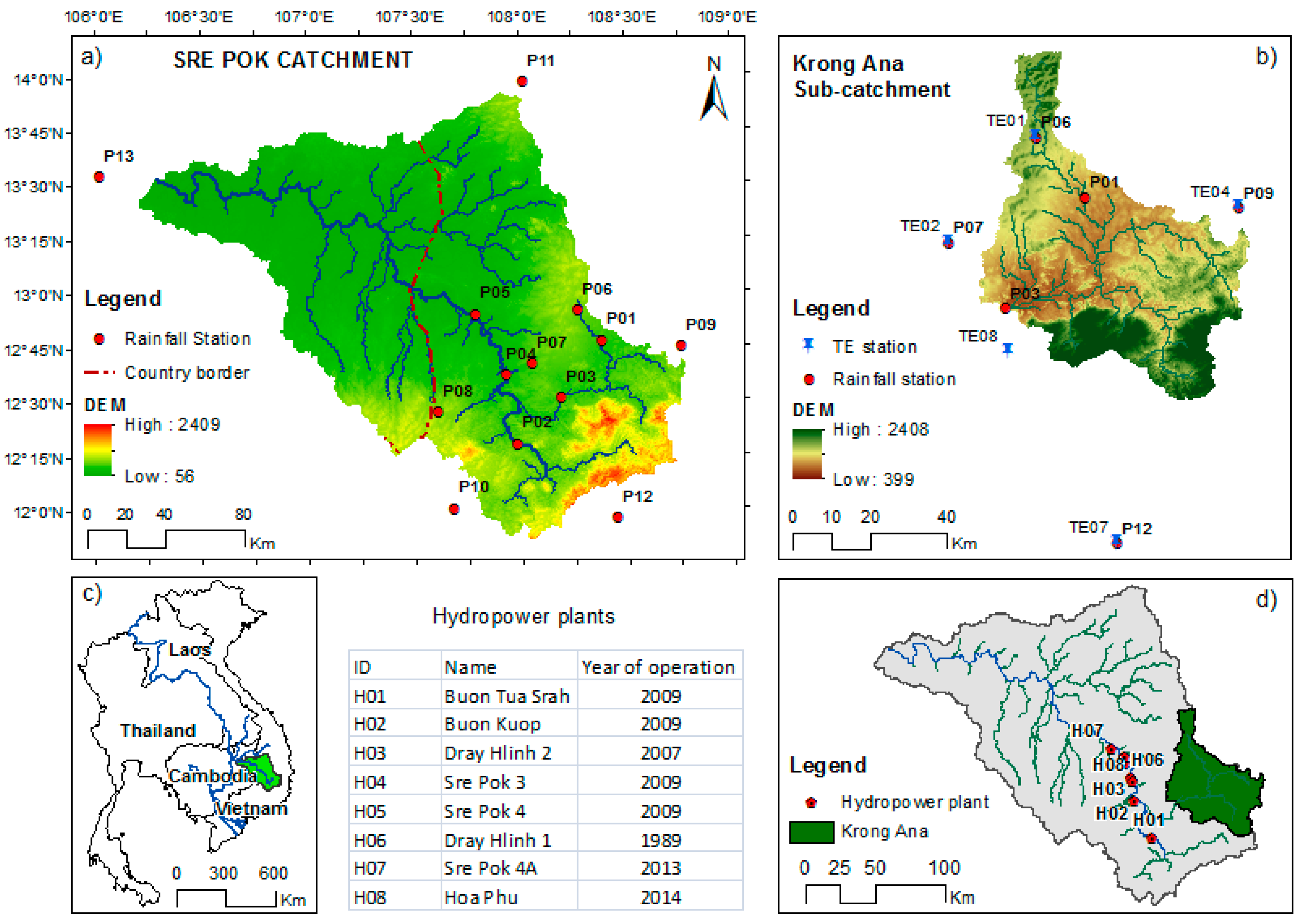
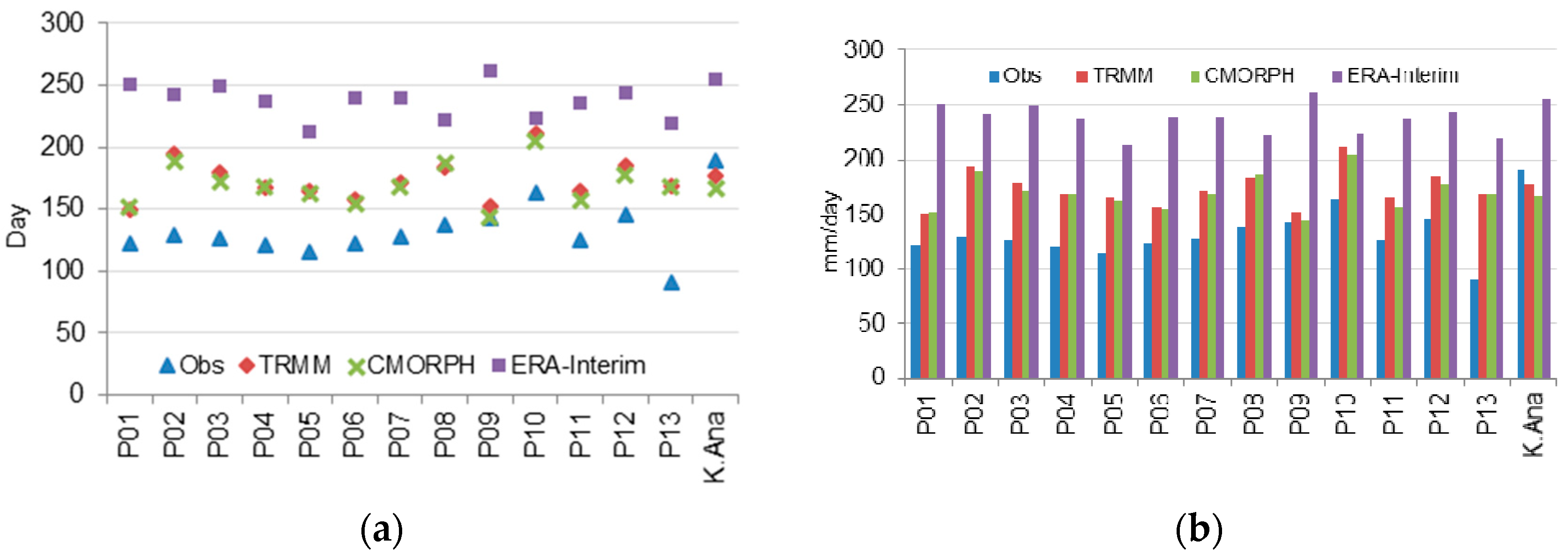

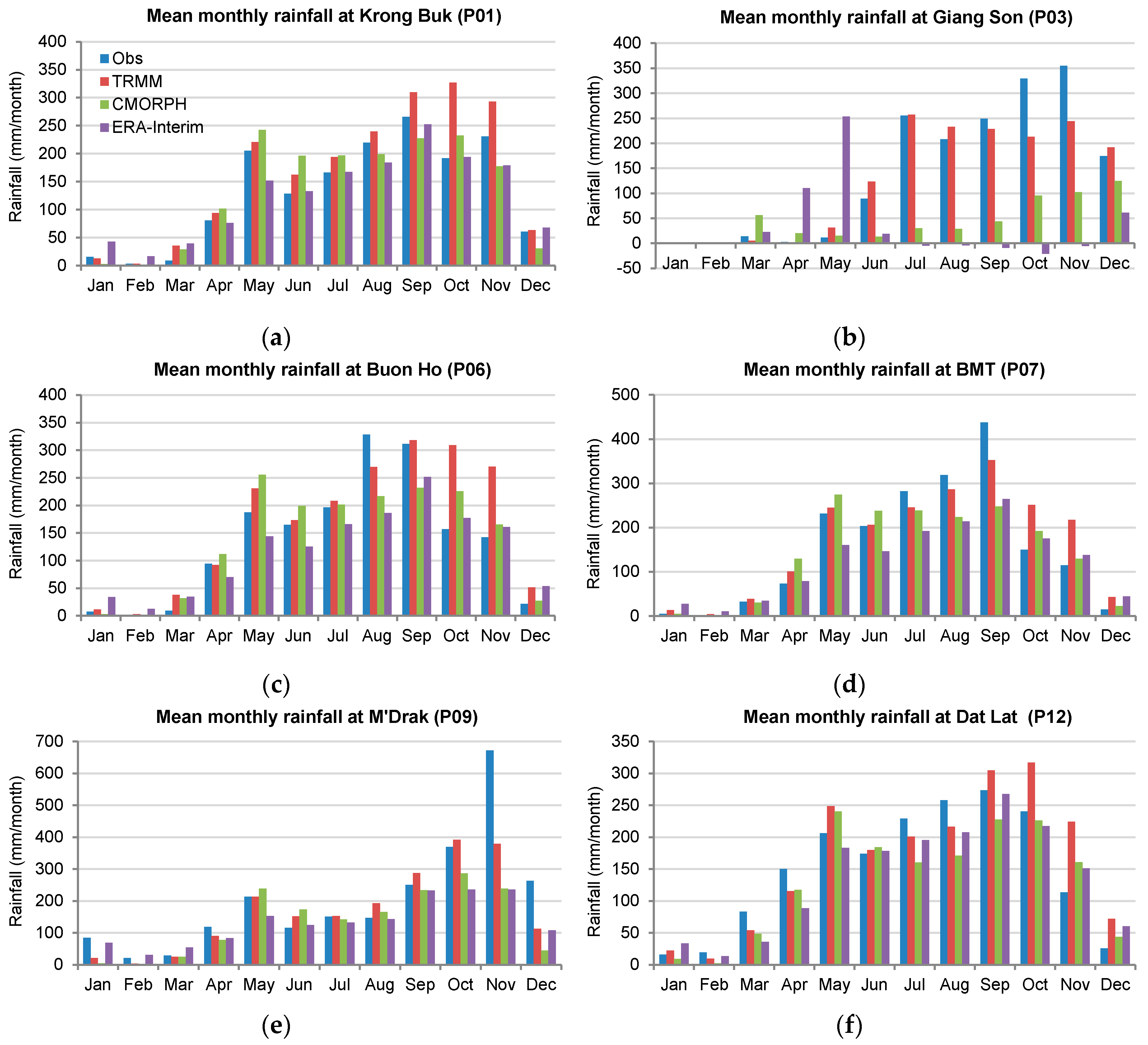


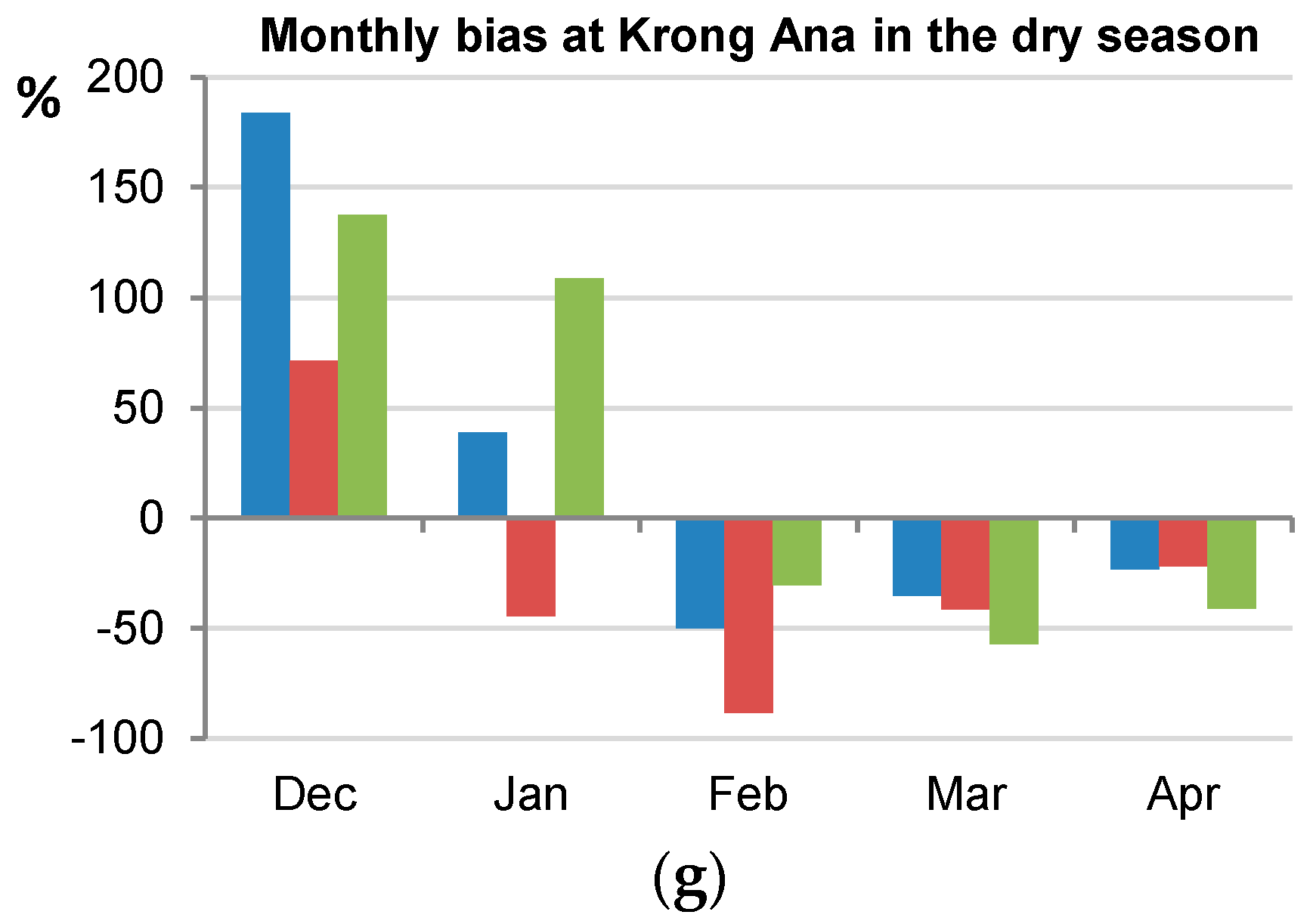
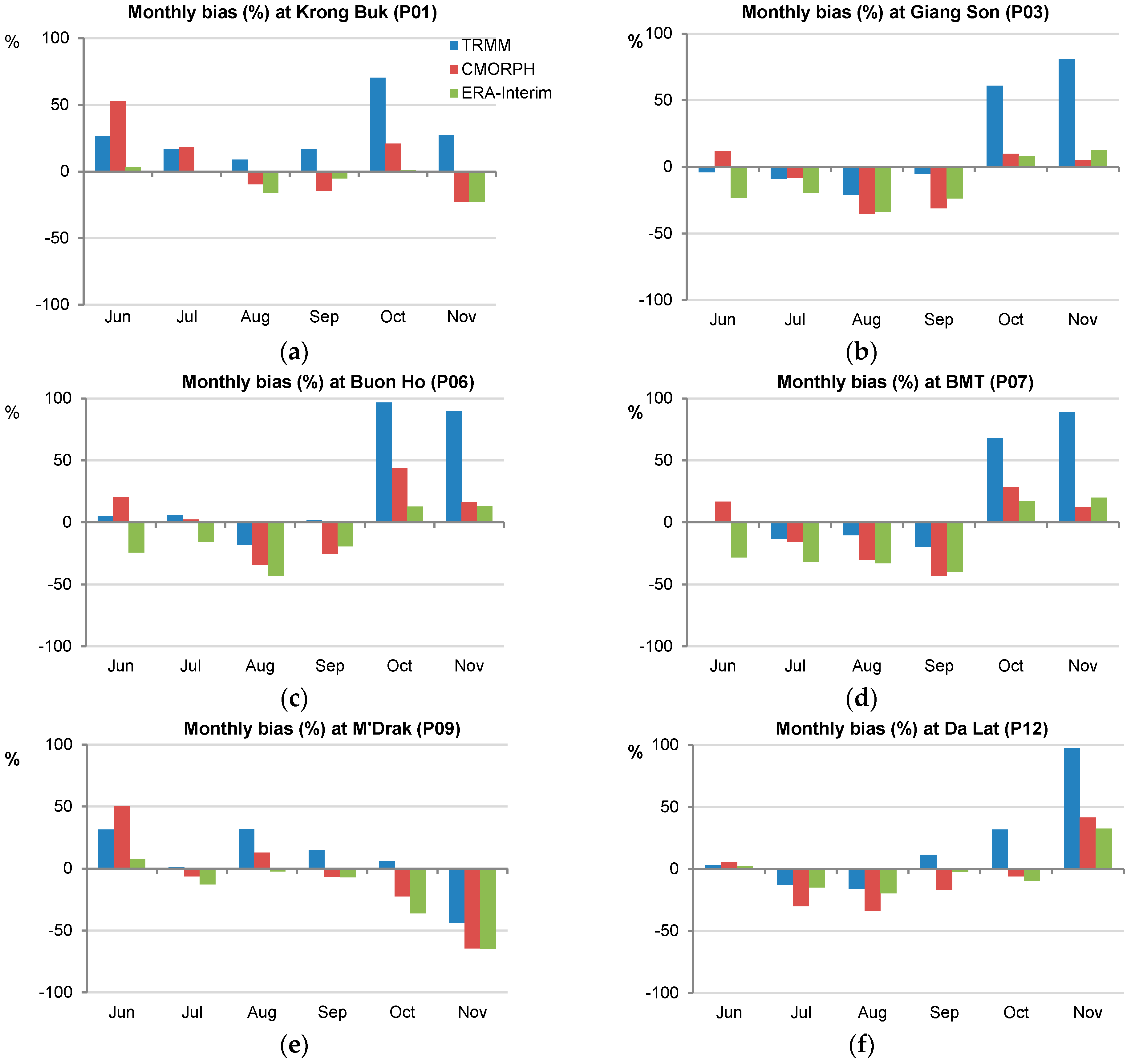

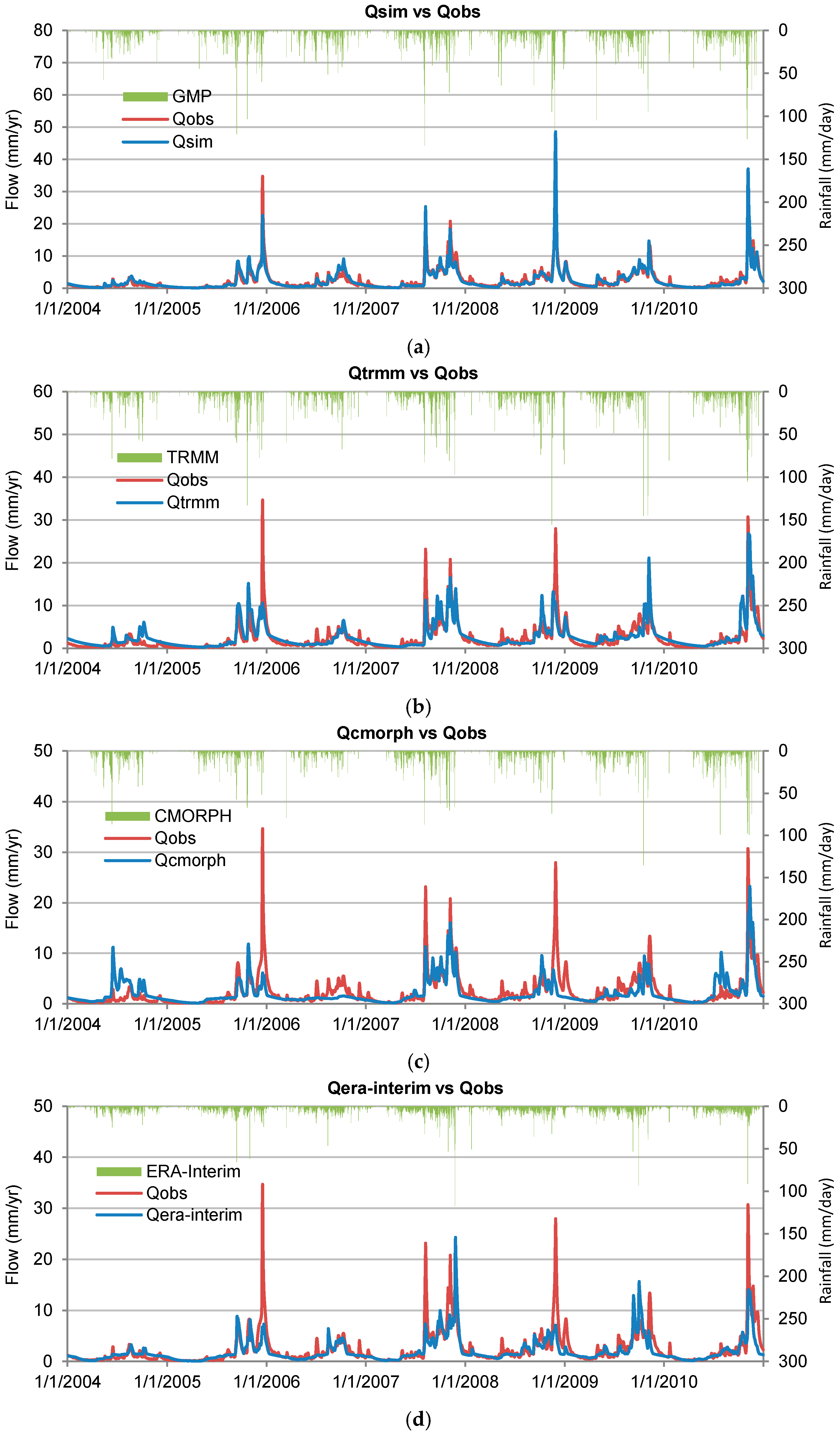
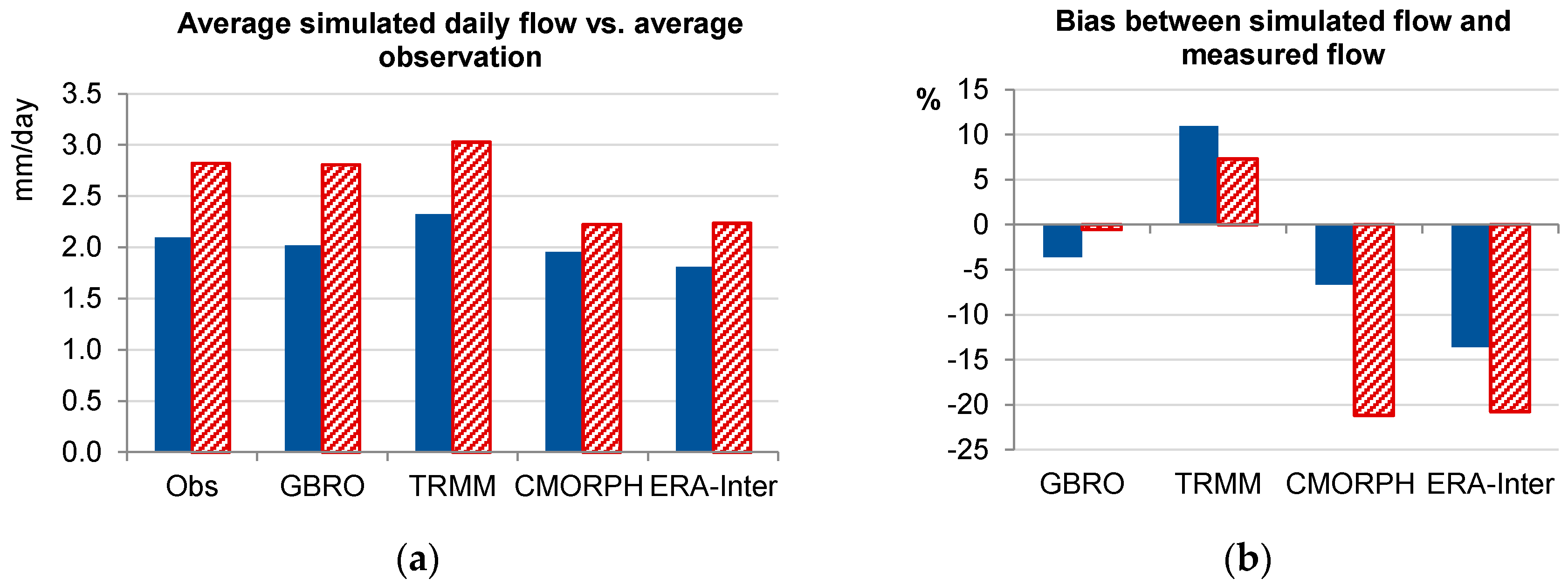
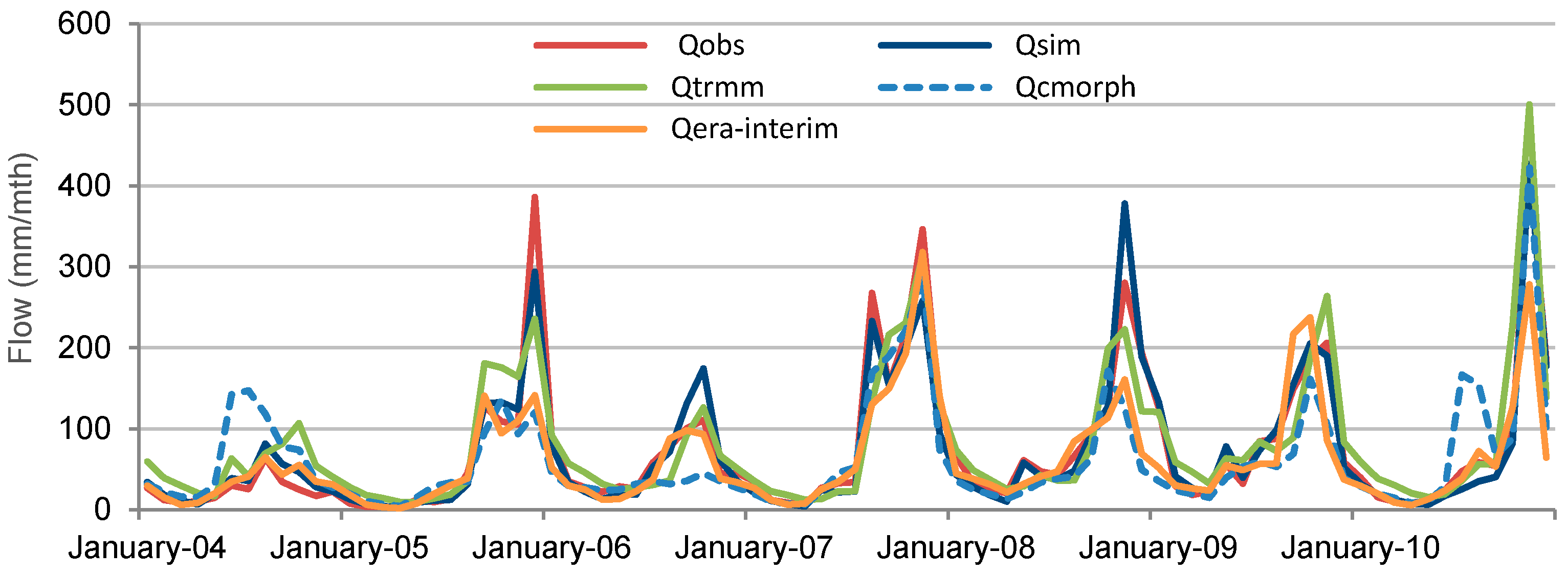
| ID | Name | Latitude | Longitude | Elevation | Source |
|---|---|---|---|---|---|
| P01 | Krong Buk | 108.4 | 12.8 | 456.7 | PRoACC-II |
| P02 | Duc Xuyen | 108.0 | 12.3 | 444.6 | PRoACC-II |
| P03 | Giang Son | 108.2 | 12.5 | 428.0 | PRoACC-II |
| P04 | Cau 14 | 107.9 | 12.6 | 310.1 | WRS |
| P05 | Ban Don | 107.8 | 12.91 | 186.0 | PRoACC-II |
| P06 | Buon Ho | 108.3 | 12.9 | 707.0 | WRS |
| P07 | BMT | 108.1 | 12.7 | 472.1 | WRS |
| P08 | Dak Mil | 107.6 | 12.4 | 759.6 | WRS |
| P09 | M’Drak | 108.7 | 12.7 | 424.0 | WRS |
| P10 | Dak Nong | 107.7 | 12.0 | 623.9 | WRS |
| P11 | Pleiku | 108.0 | 14.0 | 780.3 | WRS |
| P12 | Da Lat | 108.4 | 12.0 | 1511.0 | WRS |
| P13 | Stung Treng | 106.0 | 13.5 | 52.6 | RFMMP |
| Products | Simulated Scale | Model Type | Catchment/Basin | Drainage Area (km2) | Location | Reference |
|---|---|---|---|---|---|---|
| TMPA-3B42V6 | Daily Monthly | Semi-distributed | 7 sub-basin of La Plata basin | 62,236–1,100,000 | South America | Su et al. (2008) |
| CMORPH, TMPA-RT, TMPA-V6, PERSIANN, and PERSIANN-adjustment | 6-h our Monthly | Lumped | Illinois River basin | 1489 | America | Behrangi et al. (2011) |
| CMORPH, TMPA-3B42RT, TMPA-3B42, and PERSIANN | Daily | Distributed | Gilgel Abay watershed | 1656 | Ethiopia | Bitew and Gebremichael (2011) |
| CMORPH, RFE2.0, TRMM-3B42, PERSIANN, and ERA-Interim | Daily | Distributed | 4 sub-basins of Volta and Baro-Akobo basins | 50,000–130,000 | Africa | Thiemig et al. (2013) |
| TMPA 3B42V6, TMPA 3B42RT, and CMORPH | Daily Monthly | Distributed | Mishui basin | 9972 | South China | Jiang et al. (2012) |
| TMPA-3B42V6 | Daily Monthly | Distributed | Yellow River basin | 122,000 | China | Meng et al. (2014) |
| NOAA RFE2.0 | Daily | Semi-distributed | 4 sub-basins of Nile and Mekong rivers | 2646–22,150 | Eritrean, Ethiopia and Lao PDR | Artan et al. (2007) |
| No. | Type of Satellite Based Rainfall Product | Availability | Resolution | Downloading Period | Source | |
|---|---|---|---|---|---|---|
| Spatial (lat × lon) | Temporal | |||||
| 1 | ECMWF (ERA-Interim) | Globally (1979-present) | 0.25° × 0.25° | 6 h | January 2003–December 2010 | http://apps.ecmwf.int/ |
| 2 | CMORPH | 60N-60S (2003-present) | 0.25° × 0.25° | 3 h | January 2003–December 2010 | http://rda.ucar.edu/ |
| 3 | TRMM (3B42-V7) | 50N-50S (1998-present) | 0.25° × 0.25° | 3 h | January 2003–December 2010 | http://mirador.gsfc.nasa.gov/ |
| ID | Daily Indicators | Monthly Indicators | ||||||||||
|---|---|---|---|---|---|---|---|---|---|---|---|---|
| R2 | NSE | R2 | NSE | |||||||||
| TRMM | CMORPH | ERA-Interim | TRMM | CMORPH | ERA-Interim | TRMM | CMORPH | ERA-Interim | TRMM | CMORPH | ERA-Interim | |
| P01 | 0.39 | 0.32 | 0.14 | 0.17 | 0.23 | 0.13 | 0.81 | 0.68 | 0.68 | 0.66 | 0.62 | 0.67 |
| P02 | 0.26 | 0.24 | 0.12 | 0.08 | 0.13 | 0.08 | 0.73 | 0.71 | 0.63 | 0.72 | 0.71 | 0.61 |
| P03 | 0.30 | 0.22 | 0.17 | 0.12 | 0.13 | 0.16 | 0.70 | 0.59 | 0.74 | 0.69 | 0.58 | 0.68 |
| P04 | 0.28 | 0.27 | 0.16 | 0.02 | 0.11 | 0.14 | 0.79 | 0.69 | 0.67 | 0.74 | 0.66 | 0.65 |
| P05 | 0.31 | 0.24 | 0.16 | 0.07 | 0.05 | 0.14 | 0.78 | 0.75 | 0.71 | 0.65 | 0.71 | 0.69 |
| P06 | 0.32 | 0.28 | 0.19 | 0.11 | 0.18 | 0.18 | 0.58 | 0.51 | 0.63 | 0.47 | 0.48 | 0.60 |
| P07 | 0.28 | 0.21 | 0.17 | 0.17 | 0.14 | 0.16 | 0.76 | 0.61 | 0.69 | 0.75 | 0.60 | 0.60 |
| P08 | 0.26 | 0.28 | 0.13 | 0.04 | 0.16 | 0.09 | 0.78 | 0.82 | 0.70 | 0.72 | 0.80 | 0.68 |
| P09 | 0.36 | 0.26 | 0.20 | 0.33 | 0.24 | 0.17 | 0.62 | 0.40 | 0.52 | 0.57 | 0.32 | 0.33 |
| P10 | 0.27 | 0.22 | 0.17 | 0.23 | 0.19 | 0.14 | 0.74 | 0.60 | 0.72 | 0.69 | 0.54 | 0.53 |
| P11 | 0.34 | 0.31 | 0.24 | 0.27 | 0.28 | 0.23 | 0.74 | 0.65 | 0.72 | 0.73 | 0.61 | 0.60 |
| P12 | 0.26 | 0.24 | 0.14 | −0.08 | 0.10 | 0.11 | 0.67 | 0.66 | 0.65 | 0.60 | 0.61 | 0.63 |
| P13 | 0.13 | 0.11 | 0.11 | −0.16 | −0.37 | 0.08 | 0.76 | 0.62 | 0.65 | 0.50 | 0.27 | 0.59 |
| K.Ana | 0.49 | 0.37 | 0.26 | 0.34 | 0.33 | 0.24 | 0.83 | 0.65 | 0.74 | 0.81 | 0.61 | 0.67 |
| Calibration | Validation | |||||||
|---|---|---|---|---|---|---|---|---|
| GMP | TRMM | CMORPH | ERA-Interim | GMP | TRMM | CMORPH | ERA-Interim | |
| Daily simulation | ||||||||
| R2 | 0.89 | 0.67 | 0.53 | 0.56 | 0.88 | 0.65 | 0.45 | 0.52 |
| NSE | 0.89 | 0.67 | 0.52 | 0.55 | 0.76 | 0.61 | 0.41 | 0.49 |
| LogNSE | 0.89 | 0.62 | 0.64 | 0.81 | 0.88 | 0.68 | 0.59 | 0.74 |
| Bias (%) | −3.61 | 10.93 | −6.66 | −13.61 | −0.52 | 7.32 | −21.17 | −20.75 |
| Monthly accumulation | ||||||||
| R2 | 0.93 | 0.78 | 0.59 | 0.78 | 0.96 | 0.84 | 0.64 | 0.69 |
| NSE | 0.92 | 0.77 | 0.58 | 0.74 | 0.95 | 0.80 | 0.59 | 0.63 |
| LogNSE | 0.92 | 0.67 | 0.68 | 0.87 | 0.92 | 0.75 | 0.64 | 0.80 |
© 2018 by the authors. Licensee MDPI, Basel, Switzerland. This article is an open access article distributed under the terms and conditions of the Creative Commons Attribution (CC BY) license (http://creativecommons.org/licenses/by/4.0/).
Share and Cite
Nguyen, T.H.; Masih, I.; Mohamed, Y.A.; Van der Zaag, P. Validating Rainfall-Runoff Modelling Using Satellite-Based and Reanalysis Precipitation Products in the Sre Pok Catchment, the Mekong River Basin. Geosciences 2018, 8, 164. https://doi.org/10.3390/geosciences8050164
Nguyen TH, Masih I, Mohamed YA, Van der Zaag P. Validating Rainfall-Runoff Modelling Using Satellite-Based and Reanalysis Precipitation Products in the Sre Pok Catchment, the Mekong River Basin. Geosciences. 2018; 8(5):164. https://doi.org/10.3390/geosciences8050164
Chicago/Turabian StyleNguyen, Thu Ha, Ilyas Masih, Yasir A. Mohamed, and Pieter Van der Zaag. 2018. "Validating Rainfall-Runoff Modelling Using Satellite-Based and Reanalysis Precipitation Products in the Sre Pok Catchment, the Mekong River Basin" Geosciences 8, no. 5: 164. https://doi.org/10.3390/geosciences8050164





